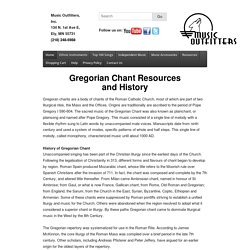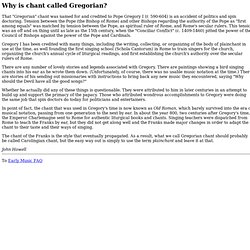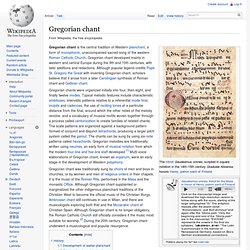

Gregorian Chant Resources and History. Gregoran chants are a body of chants of the Roman Catholic Church, most of which are part of two liturgical rites, the Mass and the Offices.

Origins are traditionally are ascribed to the period of Pope Gregory I 590-604. The sacred music of the Gregorian Chant was also known as plainchant, or plainsong and named after Pope Gregory. This music consisted of a single line of melody with a flexible rhythm sung to Latin words by unaccompanied male voices. Manuscripts date from ninth century and used a system of modes, specific patterns of whole and half steps. Gregorian chant (music. Why is chant called Gregorian? That "Gregorian" chant was named for and credited to Pope Gregory I (r. 590-604) is an accident of politics and spin doctoring.

Tension between the Pope (the Bishop of Rome) and other Bishops regarding the authority of the Pope as "first among equals" was matched by tension between the Pope, as spiritual ruler of Rome, and Rome's secular rulers. This tension was an off and on thing until as late as the 15th century, when the "Conciliar Conflict" (c. 1409-1460) pitted the power of the Council of Bishops against the power of the Pope and Cardinals. Gregorian Chant Benedictinos. Gregorian chant. Gregorian chant is the central tradition of Western plainchant, a form of monophonic, unaccompanied sacred song of the western Roman Catholic Church.

Gregorian chant developed mainly in western and central Europe during the 9th and 10th centuries, with later additions and redactions. Although popular legend credits Pope St. Gregory the Great with inventing Gregorian chant, scholars believe that it arose from a later Carolingian synthesis of Roman chant and Gallican chant.